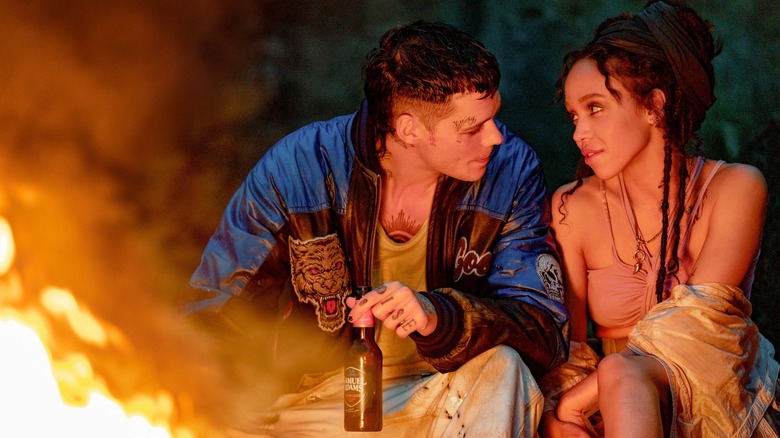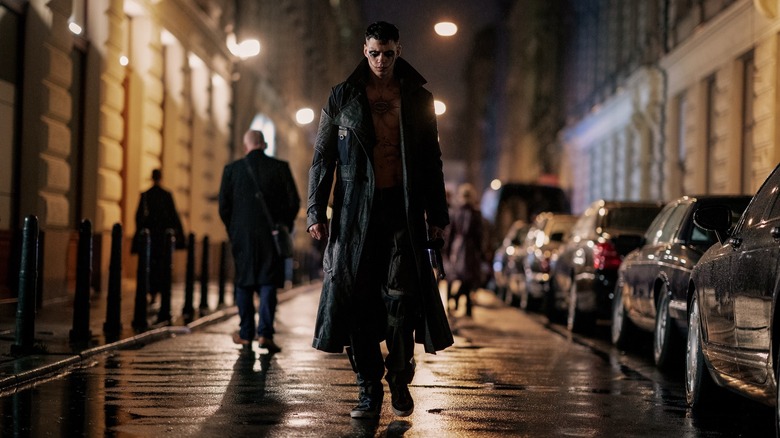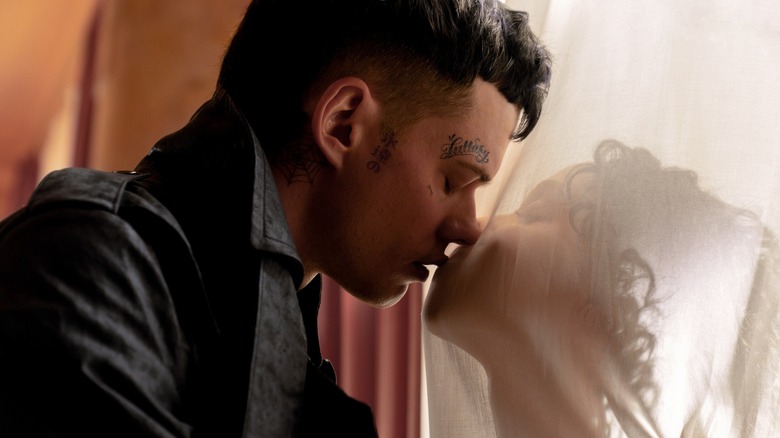The Ending Of The Crow Explained
Contains spoilers for "The Crow"
For those who remember the 1994 movie or the 1989 graphic novel by James O'Barr that it's based on, the 2024 version of "The Crow" is a familiar story. Eric (Bill Skarsgård) and Shelly (FKA twigs) fall in love after they meet in a rehab facility. When they're murdered on the orders of a figure out of Shelly's recent past, Eric's desire for vengeance and his love of Shelly propel him to come back from the dead and take revenge against those who killed them.
That's part of 2024's "The Crow" but the story has been made more complex. The bad guy now has a supernatural element too, making the two sides more of a match for each other. There are other changes as well, and we'll tell you about all of them here. That includes how this iteration of "The Crow" differs from both the graphic novel and the 1994 movie, and what the new film's ending could mean for the franchise. This is the ending of the 2024 version of "The Crow," explained.
What you need to remember about the plot of The Crow (2024)
"The Crow" starts when Shelly's friend, Zadie (Isabella Wei), sends her a video of a night that no one wants to remember. We don't see the entire video at first, but there's enough in it for Zadie to tell Shelly to get out of town. Before Zadie can even leave her own apartment, she's captured by Marian (Laura Birn) and her goons. Shelly tries to escape, but when a man follows her, she runs into a pair of cops and lets her purse fall so she is caught with drugs.
At the same time, Marian takes Zadie to her boss, Vincent Roeg (Danny Huston). It turns out that Roeg made a deal with the devil: If Roeg sends people's souls to hell, he will live as an immortal. He proceeds to whisper words in a demonic language to Zadie and then hands her a knife, which she uses to repeatedly stab herself with.
Shelly is sent to rehab, where she meets and flirts with Eric. When Marian and Shelly's mother Sophia (Josette Simon) come to see her, Eric and a frightened Shelly escape the facility together. They proceed to fall in love, but another friend, Dorm (Sebastian Orozco), comes to see Shelly after Zadie's body is found and tells her that she has to get out of town. Shelly and Eric go to his place, where she promises she'll tell him everything, but before she gets a chance, Marian and company are upon them. They both have bags put over their heads and suffocate to death.
The Crow is reborn
Eric wakes up in the river and follows a strange man to Limbo, visualized as an abandoned railyard full of crows. The man, Kronos (Sami Bouajilla), tells Eric that he's dead, but has been revived to take vengeance on the people who wronged him and Shelly. If he finishes this mission both he and Shelly will return to life. Eric doesn't believe him, but returns to the real world and is confronted by Detective Milch (Dukagjin Podrimaj). Milch is on Roeg's payroll and shoots Eric through the heart, but Eric doesn't die even though he feels pain. Once he realizes this, he fights and kills Milch.
Eric begins to embrace his mission, but then he sees the video of Shelly and her friends, which shows Roeg whispering in Shelly's ear, prompting Shelly to kill someone. Before he can decide how he feels about this, Eric is confronted by three of Roeg's goons. One of them accidentally shoots him and Eric is surprised to learn that he's actually bleeding from the wound this time. He returns to the railyard, where Kronos tells Eric that since he doubted Shelly, his deal is off. Eric offers to trade his soul for Shelly's and Kronos agrees.
What happened at the end of The Crow (2024)?
Eric is revived in the place where he died and kills the three goons that originally murdered him. Then Eric looks at one of their phones, which has a text message that says Marian will be at the opera house. Eric paints his face and goes there to confront her. He gruesomely slaughters her entire security team, leaving a pile of bodies and severed limbs, and then kills Marian after she tells him that Roeg is at his estate.
Eric "borrows" Marian's car and drives to the house, where he finds Roeg and fights him. Roeg whispers in his demonic language to Eric and stabs him through the heart. At first, it appears as though Roeg has won, but after Eric remembers his and Shelly's past, he wakes up and hurls himself and Roeg out the window. They land in the ghostly railyard, where Roeg is carried down to hell by demons. Shelly is revived and Eric gets to spend a few minutes with her explaining why he can't come back to the land of the living. She goes on to have a music career, and Eric says he'll be waiting for her.
What the end of The Crow means
The ending of "The Crow" is intended to mean that, as the posters say, "true love never dies." Even though Eric and Shelly have been separated by death, he continues to love her, and although she doesn't say it, she presumably continues to love him too. Of course, at the end of the movie, Eric says that waiting for Shelly to finish her life is "almost" enough. The question is what does that "almost" mean? Does it mean he still wants to be with her in this life and he'll break his word with Kronos to do it? Or does it mean he wants to help others who have been wronged and will help them become undead figures of vengeance too? Since Eric utters this at the very end of the movie, it seems meant to be ambiguous.
In the meantime, though, we can be assured that the wicked in this scenario are punished and at least some of the good guys survive. The real victory is that Eric helps destroy Vincent Roeg, someone who had lived for hundreds of years by killing others who went to hell in his place. While Eric can't help anyone else who was condemned to hell by Roeg except Shelly, he ensures that no one else will suffer in exchange for Roeg's immortality.
What does the horse's death at the beginning mean?
At the very beginning of the movie, before we move to the present day, there's a flashback to when Eric was younger. He's walking home and finds a horse in a field that's entrapped by barbed wire. Young Eric (Solo Uniacke) runs to it and removes the barbed wire but can't save the horse from dying. The barbed wire scars his hands and the incident continues to haunt him as he gets older.
While this is something Eric also experiences in the graphic novel the movie is based on, Eric is already The Crow when he sees this and the scene in the book is a dream. He also sees the horse running first. For this reason, it seems like the scene has different meanings in the graphic novel and the movie. In the graphic novel, it's a symbol that Eric as The Crow is still compassionate and still cares about those who are innocent and good. In the movie, it's an early trauma for Eric: The horse is an innocent that dies for no good reason, and Eric can't help it. That could be part of why he's able to come back from the dead to help Shelly.
Why does Roeg die a supernatural death?
Everyone in this version of "The Crow" dies a very real death, except Vincent Roeg. They die by gunfire, knives, or other weapons that Eric uses. Even Eric, who can't die, can be hurt extremely badly, which we see when he breaks his leg or has an organ literally fall out of his body where someone stabs him. But Roeg doesn't experience any of this. Instead he dies a supernatural death, with no blood at all — but perhaps a fate even worse.
The reason for this is presumably that Roeg is a supernatural being as a result of his bargain with the devil. Yet when Eric drives him out of the window of his estate, Eric, a supernatural being now himself, is somehow able to drag Roeg back with him into the railyard that symbolizes the netherworld between heaven and hell. Once Roeg is there, Eric is able to turn him over to the demons from hell that rise out of the black water which permeates the railyard. Whether Kronos has a hand in this is not clear, but it seems apparent that someone who can't be killed like a normal, mortal human being will have to be transported to the afterlife to finally be physically dragged down to their punishment.
How does The Crow (2024) compare to the graphic novel?
Of all the versions of "The Crow," the original graphic novel tells the most straightforward iteration of the narrative. As in the movies, it centers around Eric coming back to get revenge on everyone involved in the killing of him and Shelly. But the love story is less fleshed out, and there are flashbacks instead to the life that he and Shelly had, helping the reader understand their love through the intensity of Eric's need for revenge.
The graphic novel also doesn't include anything about Roeg or any of his underlings; instead it's a street gang that comes upon Eric and Shelly one night and decide to kill them. These are the people that Eric goes after when he's resurrected. There are no higher-ups or others for him to take out. Also there's no reason for the violent killing of Eric and Shelly, as there is in the movie — they just happen to be there.
However, there is a character in the graphic novel — who was cut from the 1994 movie of "The Crow" – that at least has a passing resemblance to a character in the new movie. In the graphic novel, he's known as the Skull Cowboy. We don't know much about him, but he appears at times to comment on what Eric does and seems to be related to Limbo and the crows that follow Eric. In the film, the character named Kronos is a bit like the Skull Cowboy, and although Kronos is far more helpful to Eric, he is still attached to Limbo and the crows.
How does the 2024 movie compare to the 1994 version?
The 1994 version of "The Crow" is also a far simpler story, although it's slightly more complicated than the graphic novel. In the 1994 version, Eric (the late Brandon Lee) and Shelly (Sofia Shinas) are killed after she writes to the housing board about their pending eviction. Thugs are then dispatched to their home to scare her into being quiet, but Eric walks in halfway through the assault and they end up killing both him and Shelly as a result.
Eric successfully sets out after the thugs who killed him, but unlike the 2024 version, he's ready for death again if it's not for the fact that Sarah (Rochelle Davis), the little girl that he and Shelly took care of when they were alive, is taken hostage by thug leader Top Dollar (Michael Wincott). Also, unlike the 2024 movie, a cop, Sergeant Albrecht (Ernie Hudson), helps Eric in his quest for vengeance.
But the main point of departure may be the way Eric himself looks. In 1994, Lee sported a heavy metal grunge look complete with long hair and stylized face paint, a look more reminiscent of the comics. In 2024, Bill Skarsgård has a more emo-punk look, with lots of tattoos and short hair, which Twitter users say reminds them of Jared Leto's much-maligned Joker in 2016's "Suicide Squad."
What did star Bill Skarsgård say about the ending of the movie?
Star Bill Skarsgård has emphasized that the 2024 version of "The Crow" is distinct from the 1994 film. He told People, "We were not remaking that movie, and that was never the intention. I feel like that movie and [Brandon Lee's] performance is iconic and shouldn't be tampered with at all. So I'm glad that we tried to do something very different with it."
The story is certainly different, and as much as Skarsgård believes in this iteration of "The Crow," the thing that has gotten the most publicity has been what he said about the ending. He told Esquire, "I personally prefer something more definitive." This indicates that when it comes to the ending, it's less final than originally conceived. This seems to be especially the case when it comes to the word "almost" in the final voice-over. If Eric's "almost" means he's not quite satisfied with how things turned out, he could come back — something Skarsgård didn't want the movie to indicate.
What did director Rupert Sanders say about the ending of the movie?
While Bill Skarsgård has clearly expressed his reservations about the ending, director Rupert Sanders has a more positive view. "The film is very much an origin story, but I do think it stands alone," he told Forbes. "As an audience member, I hate spending my money, going for two hours and then being like, 'To be continued' ... I won't wait two years for that next bit."
While Sanders doesn't think the movie is as open-ended as Skarsgård believes, he does have ideas about a sequel. "'The Crow' Gods will guide us as to whether I think there is an amazing opportunity to see Eric moving between worlds... and being vengeance," he told Forbes. "That's a different tone of movie. However, if it doesn't happen, so be it. I'm very proud of how 'The Crow' ends emotionally." Sanders clearly thinks the ending of his 'The Crow' fulfilled its mission. We'll see if audiences agree with him.
Is there a sequel in the works?
As of now, there's isn't a followup in the works for "The Crow," but that doesn't mean Rupert Sanders, at least, wouldn't be open to a sequel. He's clearly interested in doing another movie that continues the story of Eric specifically. While the 1994 movie spawned a series of sequels, none of these again featured Eric. In fact, the only screen version that continued Eric's story is the TV show that no one talks about, "The Crow: Stairway to Heaven," which lasted just one season. So this might be a different take on the continuation of Eric's story.
If there is enough interest from audiences to do a sequel, in order for Sanders to get his wish to have Eric again move between the worlds of the living and the dead, he would also have to entice Bill Skarsgård. But Skarsgård seems only lukewarm on the idea of a continuation. So Sanders has a couple of big hurdles to jump before getting to make a sequel — the most important being, will audiences even warm to the world that he's set up?
What the end of The Crow could mean for the franchise
If this iteration of "The Crow" continues in a sequel, the slightly open-ended conclusion of the movie could play a big role in how the rest of the franchise plays out. This is a different take on "The Crow." It's more supernatural in nature, an aspect of this version of the story that Sanders could take and build on.
In the film, the villainous Vincent Roeg makes a deal with the devil to live forever. There may be others like him, so Eric could go after these individuals and their cronies. Or he could go on a quest to free others that Roeg has sent to hell. Either of these could be interesting because they would take things in a different direction than Eric's gone in the past. But whether the franchise carries on or stalls out here is really the audience's call, and they'll show their support by turning up ... or not.












